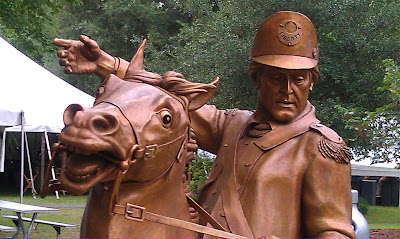I have blogged some recently about the Civil War and the handprint that it left on Charleston, South Carolina. Thanks to the Sesquecentenial Commemoration, alot of the history buzz currently eminating from the picturesque historic streets and waterways of Charleston relates to affairs from the late 1800's. With the current focus on the Civil War one may be tempted to forget about that other remarkable war in Charleston's past, the Revolutionary War.
Life in Pre-Revolutionary War Charles Town was a dichotomy, the ruling class wealthy continued to accumulate wealth and status while the lower class continued to become more poverty stricken. During this time, Charles Town was the fourth largest city in the new world, ranking behind Philadelphia, New York and Boston. In order to address the needs of a rapidly growing poverty class, the churchmen of the ruling class raised taxes at an alarming rate from the 1750's to the late 1760's, and as you might imagine, this helped to make Charles Town a tinder box for revolution. Given the prominence of the city with respect to population and considering the un-rest that was building over taxation and other social and political issues it is easy to understand that when the rubber hit the road in terms of revolution, Charles Town and it's dynamic leaders would play a pivotal role in the developing conflict.
If you know anything about modern day Charleston, and you are a fan of the history of Charleston you would be somewhat less than astounded to find out that there were many eccentric and dynamic characters who would contribute in large fashion to some colorful accounts before, during and after the war for American Independence.
The stories surrounding one such Revolutionary War figure, Francis Marion, illustrate him in nearly fictional terms as a bigger-than-life action hero. The movie, The Patriot, is "loosely" based upon Marion and his role in the American victory of the late 1700's. There are colleges, universities, forests, parks, towns and highways named after Francis Marion. Part of my attraction to Marion is that the county of my home in West Virginia was named in honor of the General, Marion County. Of course, I have seen the film The Patriot easily 100 times, and along with Braveheart is among my favorites. Even though the creators of The Patriot embellished the character Benjamin Martin, the story lines do parallel to a degree the legends of the Swamp Fox, Francis Marion. It is fitting that I now drive to and from work along a by-way that was once frequented by one of my favorite Revolutionary War Characters. Each morning on my way up Highway 61 from Charleston toward my house in White Gables I picture British troops marching along the corridor only to be ambushed by Marion and his militia who then in my minds eye race on their horses until they disappear into the swampy woods surrounding the Ashley River as I cross Bacons Bridge enroute to my daytime slumber at home.
So, you might imagine how excited I was when after our weekly Saturday Evening church service at Bethany United Methodist in Summerville to drive by Azaelia Park and see a larger than life golden bronze sculpture of General Francis Marion and his steed, Ball on site for the Sculpture in the South show being held this past weekend in the park. The show was closed for the day but an extremely accomodating Summerville City Policemen who was providing after hours security allowed me to go in and take a picture of the extremely life-like statue. I think you will agree that the fury in the eyes of the horse captured by the artist, Alex Palkovich, justifies in large part the legend of Francis Marion, the Swamp Fox of the Revolutionary War.

One of my favorites as well. Disney did several shows on him with Leslie Nielson in the role of the Swamp Fox. Probably before your time. About 5 of those shows were released on DVD by the Disney Corp along with Elfago Baca. Why the rest of them have not been offered up is a mystery to me. I recently blurbed about my desire to see Charleston celebrate her role in the revolution though it was a surrender after a siege with the resulting POW count the highest in war time history until WWII. Guess that is one reason they don't. There is so much more than the Civil War and slavery to be opened up to the tourist public. Pirates were socially acceptable here in the 1600's and early 1700's. Arrrgh! Such a varied history.
ReplyDelete